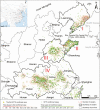Epidemiology and Ecology of Severe Fever With Thrombocytopenia Syndrome in China, 2010‒2018
- PMID: 33068430
- PMCID: PMC8664468
- DOI: 10.1093/cid/ciaa1561
Epidemiology and Ecology of Severe Fever With Thrombocytopenia Syndrome in China, 2010‒2018
Abstract
Background: The growing epidemics of severe fever with thrombocytopenia syndrome (SFTS), an emerging tick-borne disease in East Asia, and its high case fatality rate have raised serious public health concerns.
Methods: Surveillance data on laboratory-confirmed SFTS cases in China were collected. The spatiotemporal dynamics and epidemiological features were explored. The socioeconomic and environmental drivers were identified for SFTS diffusion using survival analysis and for SFTS persistence using a two-stage generalized boosted regression tree model.
Results: During 2010‒2018, a total of 7721 laboratory-confirmed SFTS cases were reported in China, with an overall case fatality rate (CFR) of 10.5%. The average annual incidence increased >20 times and endemic areas expanded from 27 to 1574 townships, whereas the CFR declined from 19% to 10% during this period. Four geographical clusters-the Changbai Mountain area, the Jiaodong Peninsula, the Taishan Mountain area, and the Huaiyangshan Mountain area-were identified. Diffusion and persistence of the disease were both driven by elevation, high coverages of woods, crops, and shrubs, and the vicinity of habitats of migratory birds but had different meteorological drivers. Residents ≥60 years old in rural areas with crop fields and tea farms were at increased risk to SFTS.
Conclusions: Surveillance of SFTS and intervention programs need to be targeted at areas ecologically suitability for vector ticks and in the vicinity of migratory birds to curb the growing epidemic.
Keywords: SFTS; diffusion; ecology; epidemiology; modeling.
© The Author(s) 2020. Published by Oxford University Press for the Infectious Diseases Society of America.
Figures



Similar articles
-
Severe fever with thrombocytopenia syndrome incidence could be associated with ecotone between forest and cultivated land in rural settings of central China.Ticks Tick Borne Dis. 2023 Mar;14(2):102085. doi: 10.1016/j.ttbdis.2022.102085. Epub 2022 Nov 20. Ticks Tick Borne Dis. 2023. PMID: 36435169
-
A ten-year assessment of the epidemiological features and fatal risk factors of hospitalised severe fever with thrombocytopenia syndrome in Eastern China.Epidemiol Infect. 2022 Jun 21;150:e131. doi: 10.1017/S0950268822001108. Epidemiol Infect. 2022. PMID: 35726737 Free PMC article.
-
Spatial-temporal characteristics of severe fever with thrombocytopenia syndrome and the relationship with meteorological factors from 2011 to 2018 in Zhejiang Province, China.PLoS Negl Trop Dis. 2020 Apr 7;14(4):e0008186. doi: 10.1371/journal.pntd.0008186. eCollection 2020 Apr. PLoS Negl Trop Dis. 2020. PMID: 32255791 Free PMC article.
-
[A review on the epidemiology of severe fever with thrombocytopenia syndrome].Zhonghua Liu Xing Bing Xue Za Zhi. 2021 Dec 10;42(12):2226-2233. doi: 10.3760/cma.j.cn112338-20210529-00439. Zhonghua Liu Xing Bing Xue Za Zhi. 2021. PMID: 34954991 Review. Chinese.
-
[Severe fever with thrombocytopenia syndrome: epidemiology, pathophysiology, and development of specific treatment and prevention measures].Rinsho Ketsueki. 2018;59(10):2255-2259. doi: 10.11406/rinketsu.59.2255. Rinsho Ketsueki. 2018. PMID: 30305533 Review. Japanese.
Cited by
-
Spatial and Temporal Analysis of Severe Fever with Thrombocytopenia Syndrome in Anhui Province from 2011 to 2023.J Epidemiol Glob Health. 2024 Sep;14(3):503-512. doi: 10.1007/s44197-024-00235-3. Epub 2024 Sep 2. J Epidemiol Glob Health. 2024. PMID: 39222226 Free PMC article.
-
Mapping the risk distribution of Borrelia burgdorferi sensu lato in China from 1986 to 2020: a geospatial modelling analysis.Emerg Microbes Infect. 2022 Dec;11(1):1215-1226. doi: 10.1080/22221751.2022.2065930. Emerg Microbes Infect. 2022. PMID: 35411829 Free PMC article.
-
Clinical laboratory parameters and fatality of Severe fever with thrombocytopenia syndrome patients: A systematic review and meta-analysis.PLoS Negl Trop Dis. 2022 Jun 17;16(6):e0010489. doi: 10.1371/journal.pntd.0010489. eCollection 2022 Jun. PLoS Negl Trop Dis. 2022. PMID: 35714138 Free PMC article.
-
Epidemiological Characteristics of Severe Fever with Thrombocytopenia Syndrome.Am J Trop Med Hyg. 2025 Feb 18;112(5):956-962. doi: 10.4269/ajtmh.24-0616. Print 2025 May 7. Am J Trop Med Hyg. 2025. PMID: 39965218 Free PMC article. Review.
-
Combined effects of hydrological conditions and socioeconomic factors on the seasonal dynamics of severe fever with thrombocytopenia syndrome in China, 2011-2022: a modelling study.Lancet Reg Health West Pac. 2025 Apr 28;58:101564. doi: 10.1016/j.lanwpc.2025.101564. eCollection 2025 May. Lancet Reg Health West Pac. 2025. PMID: 40642049 Free PMC article.
References
-
- Liu Q, He B, Huang SY, Wei F, Zhu XQ. Severe fever with thrombocytopenia syndrome, an emerging tick-borne zoonosis. Lancet Infect Dis 2014; 14:763‒ 72. - PubMed
-
- Li H, Lu QB, Xing B, et al. . Epidemiological and clinical features of laboratory-diagnosed severe fever with thrombocytopenia syndrome in China, 2011‒17: a prospective observational study. Lancet Infect Dis 2018; 18:1127‒ 37. - PubMed

